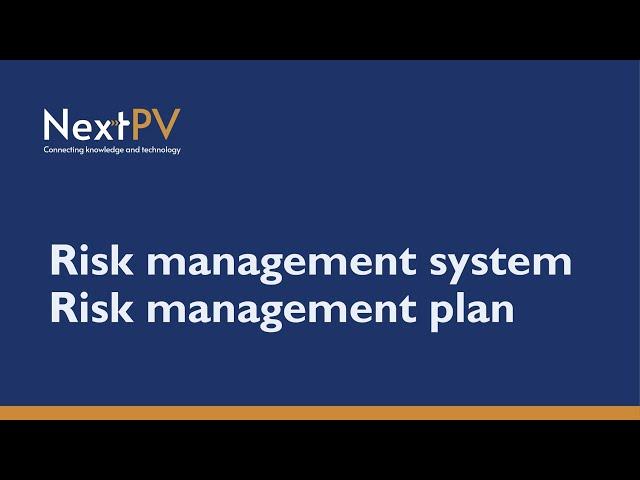
Basic Training: Risk Management Plan & Risk Management System (RMP & RMS)
🔎 Introduction to Risk Management Systems (RMS) and Risk Management Plans (RMP) in Pharmacovigilance
Risk Management Systems (RMS) and Risk Management Plans (RMP) are fundamental components of pharmacovigilance, designed to identify, assess, and mitigate risks associated with medicinal products. These systems ensure that risks are managed effectively throughout the product’s lifecycle, from development through post-marketing surveillance, thereby safeguarding patient health and ensuring regulatory compliance.
Key Aspects of RMS and RMP in Pharmacovigilance
🔎 Definition and Objectives:
An RMS encompasses all activities related to the identification, assessment, and management of risks associated with a medicinal product. An RMP is a detailed document within the RMS that outlines specific strategies and actions to minimize identified risks. The primary objectives of RMS and RMP are to ensure that the benefits of a drug outweigh its risks and to protect patient safety.
🔎 Core Components:
Safety Specification: A detailed description of the safety profile of the medicinal product, including known and potential risks, and missing information.
Pharmacovigilance Plan: Outlines activities to monitor and evaluate the drug’s safety profile, including routine and additional pharmacovigilance activities.
Risk Minimization Plan: Describes specific measures to minimize identified risks, including communication strategies and intervention measures.
Evaluation of the Effectiveness of Risk Minimization Activities: Plans for assessing how well the risk minimization measures are working.
🔎 Processes and Procedures:
The development and implementation of an RMS and RMP involve several key processes, including:
Risk Identification: Systematic identification of potential risks based on preclinical studies, clinical trials, and post-marketing data.
Risk Assessment: Evaluating the significance of identified risks using data from various sources.
Risk Control: Implementing strategies to mitigate identified risks, such as label changes, restricted distribution, or enhanced monitoring.
Risk Communication: Communicating risk information to healthcare professionals, patients, and regulatory authorities through various channels.
Continuous Monitoring and Reassessment: Regularly reviewing and updating the RMS and RMP based on new safety data and emerging risks.
🔎 Regulatory Requirements:
RMS and RMP must comply with various regulatory guidelines and requirements, including:
ICH Guidelines (E2E, E2C, E2F): Guidelines on pharmacovigilance planning, periodic benefit-risk evaluation, and development safety update reporting.
European Medicines Agency (EMA) Guidelines: Detailed requirements for RMPs and periodic safety update reports (PSURs).
Local Regulatory Frameworks: Compliance with country-specific regulations governing drug safety and risk management.
🔎 Audits and Inspections:
Regular audits and inspections of the RMS and RMP processes are essential to ensure compliance with regulatory requirements and to verify the effectiveness of the risk management strategies. These audits help identify gaps and areas for improvement in the pharmacovigilance system.
🔎 Documentation and Record Management:
Proper documentation and record-keeping are crucial for effective RMS and RMP implementation. This includes maintaining detailed records of risk assessments, risk management plans, implementation of risk minimization measures, and regulatory submissions. Accurate documentation supports transparency, regulatory compliance, and informed decision-making.
Implementing robust Risk Management Systems and Risk Management Plans ensures that the safety of medicinal products is continuously monitored and managed, thereby protecting patient health and maintaining regulatory compliance.
Risk Management Systems (RMS) and Risk Management Plans (RMP) are fundamental components of pharmacovigilance, designed to identify, assess, and mitigate risks associated with medicinal products. These systems ensure that risks are managed effectively throughout the product’s lifecycle, from development through post-marketing surveillance, thereby safeguarding patient health and ensuring regulatory compliance.
Key Aspects of RMS and RMP in Pharmacovigilance
🔎 Definition and Objectives:
An RMS encompasses all activities related to the identification, assessment, and management of risks associated with a medicinal product. An RMP is a detailed document within the RMS that outlines specific strategies and actions to minimize identified risks. The primary objectives of RMS and RMP are to ensure that the benefits of a drug outweigh its risks and to protect patient safety.
🔎 Core Components:
Safety Specification: A detailed description of the safety profile of the medicinal product, including known and potential risks, and missing information.
Pharmacovigilance Plan: Outlines activities to monitor and evaluate the drug’s safety profile, including routine and additional pharmacovigilance activities.
Risk Minimization Plan: Describes specific measures to minimize identified risks, including communication strategies and intervention measures.
Evaluation of the Effectiveness of Risk Minimization Activities: Plans for assessing how well the risk minimization measures are working.
🔎 Processes and Procedures:
The development and implementation of an RMS and RMP involve several key processes, including:
Risk Identification: Systematic identification of potential risks based on preclinical studies, clinical trials, and post-marketing data.
Risk Assessment: Evaluating the significance of identified risks using data from various sources.
Risk Control: Implementing strategies to mitigate identified risks, such as label changes, restricted distribution, or enhanced monitoring.
Risk Communication: Communicating risk information to healthcare professionals, patients, and regulatory authorities through various channels.
Continuous Monitoring and Reassessment: Regularly reviewing and updating the RMS and RMP based on new safety data and emerging risks.
🔎 Regulatory Requirements:
RMS and RMP must comply with various regulatory guidelines and requirements, including:
ICH Guidelines (E2E, E2C, E2F): Guidelines on pharmacovigilance planning, periodic benefit-risk evaluation, and development safety update reporting.
European Medicines Agency (EMA) Guidelines: Detailed requirements for RMPs and periodic safety update reports (PSURs).
Local Regulatory Frameworks: Compliance with country-specific regulations governing drug safety and risk management.
🔎 Audits and Inspections:
Regular audits and inspections of the RMS and RMP processes are essential to ensure compliance with regulatory requirements and to verify the effectiveness of the risk management strategies. These audits help identify gaps and areas for improvement in the pharmacovigilance system.
🔎 Documentation and Record Management:
Proper documentation and record-keeping are crucial for effective RMS and RMP implementation. This includes maintaining detailed records of risk assessments, risk management plans, implementation of risk minimization measures, and regulatory submissions. Accurate documentation supports transparency, regulatory compliance, and informed decision-making.
Implementing robust Risk Management Systems and Risk Management Plans ensures that the safety of medicinal products is continuously monitored and managed, thereby protecting patient health and maintaining regulatory compliance.
Комментарии:
一頓吃五餐!不是全都好吃的《林口三井OUTLET二館》|DenQ
隨便吧DenQ
CORRAN CUPONERAS **MEGA PAQUETE BAUNTY**
Cocina y Cupones Cristina
Hari Mata Hari - Stara ljubavi (Official video 2015)HD
HI FI Centar Official
Hamidshax - Best Deep House Music
Hamidshax Music


























